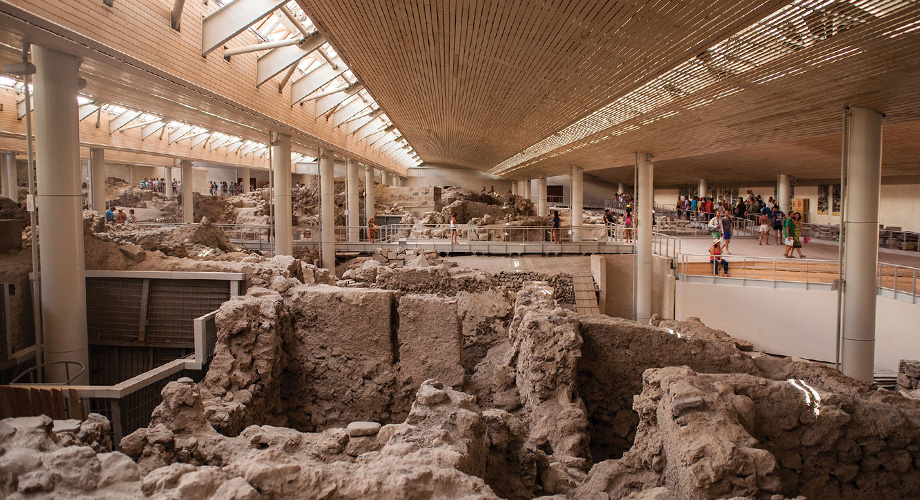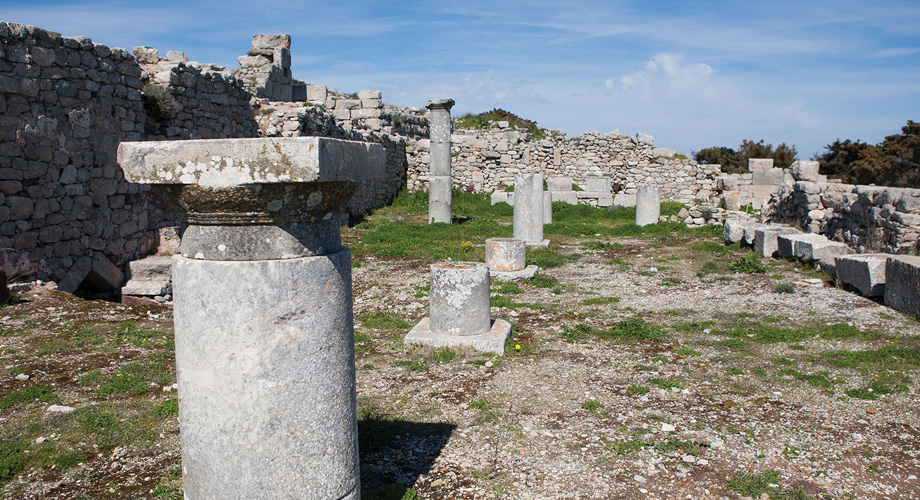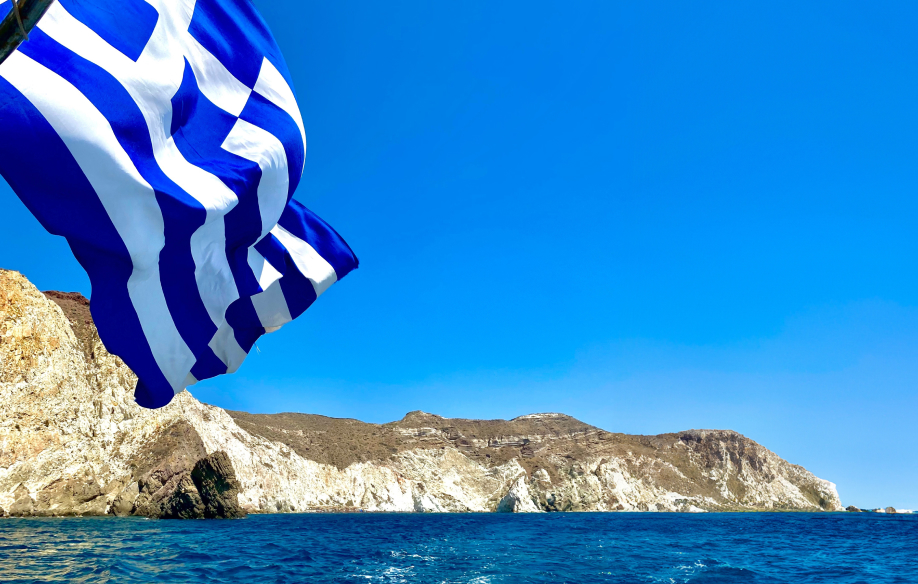The History
Legend has it that Santorini rose from the depths of the sea, a belief supported by the island’s ongoing volcanic activity and its unique geological landscape. This is the history of Santorini.
Α legacy of culture & beauty
Prehistory
The History
Legend tells that Santorini rose from the sea, a belief supported by its volcanic activity and unique geological features. Archaeological findings show that the island has been inhabited since prehistoric times, with early human remains from the Stone Age and more substantial evidence from the early Bronze Age, around the mid-3rd millennium BC. During the middle Bronze Age (1900-1600 BC), Santorini saw significant development, particularly at the prehistoric settlement of Akrotiri, which was an important port until a massive volcanic eruption around 1600 BC buried it under 30 meters of ash.

AKROTIRI
Akrotiri was a thriving Bronze Age trade centre with impressive infrastructure, buildings and a variety of unearthed objects that indicate its cultural ties with the rest of the Minoan world. But around 1630 BC, the inhabitants abandoned it, alarmed by earthquakes, soon followed by a massive eruption that covered the town in volcanic ash, thereby protecting the site, just like in Pompeii – though the absence of uninterred skeletal remains proves that in Akrotiri’s case, an orderly evacuation was performed.

ANCIENT THERA
Ancient Thera on Mesa Vouno dates back to 900 BC when it was founded by Dorian colonists and was inhabited until the Byzantine period. Today visitors can weave through its ruins and expansive necropolis, while one of its most important artefacts, unearthed in 2000, the colossal marble statue of the archaic Kore of Thera is among the prized exhibits of the Archaeological Museum in Fira.
A window to the past
Historical Times
The history
Historical Times
The 1600 B.C. eruption altered Santorini. Evidence from Monolithos shows habitation by the 13th century B.C. Herodotus recorded the island’s name changes and early settlers.
Geometric Times (10th-8th Century B.C.)
In the Geometric period, Thera adopted the Phoenician alphabet. Cemeteries in Sellada and Mesa Vouno, used until the 7th century B.C., featured imported Kouros statues.
Archaic Period (7th-6th Century B.C.)
Thera traded with Crete and Athens. In 630 B.C., Therans founded Kirini in Africa. By the 6th century B.C., Thera minted currency with dolphin imagery.
Classical-Hellenistic Times
Thera exported wine and supported Sparta during the Peloponnesian War. It became a key naval base under Alexander’s successors, vital for Aegean Sea routes.
Christian-Byzantine Period
By the 4th century, Thera had a church with Bishop Dioskouros. Arab invasions in the 9th century caused decline. The church of Episkopi Gonia was founded later.
THE RULE OF THE WEST
A tale of pirates and rulers
In 1207, Marcos Sanudos founded the Duchy of Archipelagos, with Thera and Therassia controlled by the Barotsi family until 1335. Venetians then made Santorini a Catholic Archdiocese base. In 1335, Nicolo Sanudo took control, adding the island to the Duchy of Naxos.
After 1487, Venice governed amid frequent pirate raids, leading residents to fortified settlements. In 1537, Khayr ad-Dīn Barbarossa seized the island for the Sultan. By 1579, it was ceded to the Ottoman Empire. *Source: “Santorini: And the sea brought forth the earth”/ Topio Publications/ Text by Kiki Birtacha.
Venetian Memories and Gorgeous Views
The Medieval Kastelis
After the 4th Crusade in 1204, Marco Sanudo founded the Duchy of the Aegean, with Santorini becoming the seat of one of the Duchy’s four Catholic Bishops and remaining under Venetian rule until 1579 when it became part of the vast Ottoman Empire. To witness the Medieval heritage of the island, travellers can visit the stunning Venetian kastellis of Santorini, bearing memories of the past and opening out on stunning Aegean vistas.
PYRGOS
Constructed in 1580, the Kasteli of Pyrgos is the most recent of all Santorini castles, located in the homonymous village for strategic reasons and offering unique views of the surrounding fields and the mesmerizing Aegean blue. The once impregnable castle could only be accessed by one entrance, the now-lost ‘Portara’, not far from the preserved church of Agia Theodosia.
EMPORIO
Emporio is home to the best-preserved Kasteli of Santorini. Meandering through its labyrinthical alleys is a once-in-a-lifetime experience that immerses any visitor into the aura of the past. Having charmed writers throughout the ages, with Jean-Paul Sartre most famously drawing inspiration for his play ‘Les Mouches’, a walk here is a true sensation.
AKROTIRI
At the top of Akrotiri’s Kasteli we find one of the best-preserved Goulas in Santorini. Also named ‘La Ponta’, meaning ‘The Peak’, the Kasteli of Akrotiri that once belonged to the Gozzadini family was one of the best-fortified structures of Santorini, with its imposing Goulas standing in the top of the structure. It was one of the last remaining strongholds and finally fell to the Turks in 1617.
OIA
Few words can describe the magic of a sunset from the castle of Agios Nikolaos in Oia, which was constructed around 1450 as a defensive structure against the threat of the pirates. This world-famous romantic destination owes its spellbinding views to its prime location, right on the edge of the caldera. A cherished spot that no Santorini visitor should miss!
SKAROS ROCK
In front of Imerovigli Village, the imposing Skaros rocκ is the location of a now-destroyed fortified settlement, which was once home to a dense cluster of about 200 residences, churches and monasteries that formed the erstwhile capital of Santorini until the 18th century, when it was abandoned by its residents. Today a symbol of the island, Skaros can be accessed on foot rewarding its visitors with majestic Aegean vistas.
In 1580, Sultan Murad III granted the Cycladic islands privileges that boosted trade and local governance. Christians freely built churches, totaling 700 by Richard’s count. Locals, devoted to the Virgin Mary, dedicated property to her and lived on barley bread, salted quail, and rainwater, exporting wine. The late 16th and 17th centuries saw the construction of churches and the Kasteli of Pyrgos. Jesuit monks settled in 1642, using materials from abandoned Skaros.
By the 18th century, Santorini thrived economically with a strong merchant fleet and active trade. On the eve of the 1821 revolution the Santorinian sail boats were several dozens, since the island had the third largest fleet in the Aegean Sea after the ones of Hydra and Psara. In 1856 it numbered 269 boats and the growth continued until the prevalence of steamboats in the late 19th century. Great example was Oia, the so called “village of the captains”.
The 1956 earthquake caused economic decline, but tourism began rapidly growing in the 1970s.
